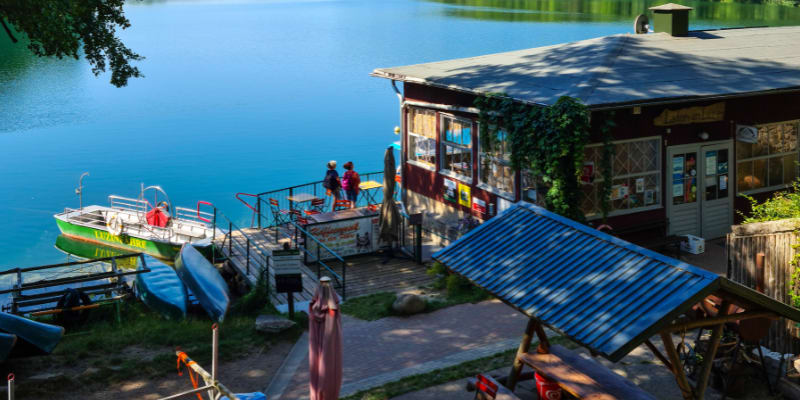Is your workplace on water? Learn how to protect workers from drowning

A job at a marina or at a lakeside summer camp is an appealing way to spend the summer. However, working near water poses a serious risk. “Drowning can happen in seconds, even for those who can swim,” says Tova Larsen, Health and Safety Consultant with WSPS.
“Unconsciousness can happen in one to three minutes, making self-rescue and non-entry rescue impossible. Cardiac arrest can occur in four to six minutes after submersion, and clinical death in ten to twelve minutes,” says Tova, emphasizing how critical it is to have a water rescue plan in place. “Preventing unexpected submersion is key, but once a worker is in the water, every second counts.” Workers need to be educated about the dangers of working near water and trained on how to do it safely.
Factors such as clothing, water temperature, and weather can put even the strongest swimmers in danger if they fall into the water unexpectedly. “If a worker trips on the dock and injures their leg right before falling into the lake, they will have a difficult time swimming,” Tova explains. “If that worker is wearing heavy work boots or a harness, it will make it even more difficult. And if the water temperature is cold, the worker may rapidly lose the ability to move their body much at all.”
Cold-water shock
“Most of us are aware of hypothermia and its effect on our body, but most do not know anything about cold-water shock,” says Tova, explaining that it is a life-threatening condition that can occur immediately upon submersion in cold water. “It is an involuntary physiological reaction that occurs specifically when an individual’s face or body is suddenly immersed in cold water. The key here is that it happens suddenly,” notes Tova.
Knowing the water temperature is critical to accurately assessing the risk of cold-water shock. “Use daily Environment Canada data from your nearest weather buoy, or measure water temperature using a weighted thermometer at a minimum of 1m below the surface,” says Tova. “Surface water warms more rapidly in warm air temperatures, leaving the top few inches feeling deceptively comfortable while the water below still presents a high risk for drowning due to cold-water shock.”
Controlling your breathing becomes difficult in a water temperature of 21 degrees Celsius and becomes progressively more difficult as the water temperature drops. Sudden immersion into water temperatures of 15 degrees Celsius or below are immediately life-threatening. “The cold-water shock reaction is at maximum intensity with a water temperature of 15 degrees Celsius. It’s the same intensity as falling through ice into frigid winter water,” says Tova.
The cold water immediately triggers involuntary gasping with a force of up to 100 times the force of a regular breath, which can cause an individual to rapidly take water into their lungs. “Drowning can happen in seconds, regardless of a person’s swimming ability,” explains Tova. Cold-water shock can also lead to hyperventilation, rapid heart rate, and even cardiac arrest from the severe restriction of blood vessels.
Aquatic versus non-aquatic staff
Employers must recognize that anytime a worker is near the water, there is a possibility of falling in. “They need to have policies and procedures in place to protect these workers from drowning,” recommends Tova.
Aquatic staff, such as certified swim instructors and lifeguards, are generally strong swimmers. But that does not mean they are not at risk. Performing in-water entry rescues puts lifeguards at risk because when someone is drowning, they frequently grab at anyone and anything nearby. “Regular in-service training that includes practicing in-water self-defence and self-rescue techniques should be part of the employer’s health and safety program,” explains Tova.
For non-aquatic employees, such as retail or serving staff at a marina, or camp counsellors who are not focused on water activities, the risks are different. “People working at waterfront workplaces may be poor swimmers or non-swimmers,” says Tova. “Employers must be aware of this and take measures to protect them.”
Personal flotation devices and the rescue chain of survival
Sometimes workers ask if they need to wear a personal flotation device (PFD) if life rings are accessible. According to Tova, the answer is absolutely yes. “Drowning is a fast and silent killer. Think of the PFD as the first link in the rescue chain of survival. It prevents immediate drowning by keeping a worker’s head above water in the event of unexpected submersion. PFDs can even help minimize the deadly effects of cold-water shock by ensuring the airway is held above water during involuntary gasping and/or swimming failure,” she explains.
Tova goes on to describe the next link in the rescue chain of survival, which is getting out of the water. “With the buoyancy support of the PFD, the worker may be able to reach a safe self-rescue location if they are physically able to do so. However, even if the worker is unable to self-rescue, the PFD buys precious minutes for others to activate an appropriate non-entry rescue or contact emergency services,” she says. “In a water emergency, a worker in a PFD can survive for hours. A worker without a PFD may only have seconds to a few minutes of survival.”
10 tips to protect workers around water
“To keep workers safe around water, complete a detailed risk assessment, develop written procedures, and train workers on those procedures,” advises Tova. “Include all workers, not only the ones who work near or in the water. “You never know what will happen or who will be around when it does. Everyone needs to know what to do in an emergency.”
As you go through the risk assessment process, break down each activity workers perform. “Consider the water temperature, the environmental conditions, the clothing or uniform workers usually wear, the ability to rescue workers from the water, and the availability of rescue equipment and emergency services,” recommends Tova.
Tova offers these 10 tips to improve your water safety procedures.
1. Prevent falls. “Preventing falls into water is the best protection against drowning,” explains Tova. Keep workers from unexpectedly entering the water by controlling fall hazards. Use high-visibility paint or tape near tripping hazards such as cleats, bumpers, valves, and other protrusions that may be found on surfaces where a worker could trip. Install guardrails or travel-restraint systems at the water’s edge, wherever it is practical. Develop footwear policies that require non-slip footwear at all times.
2. Assess underwater risks. Natural bodies of water may have dangerous currents or undertows, rocks, and man-made structures such as anchor blocks or ledges just below the surface. Pools, ponds, and tanks may have dangerous suction drains, agitators, or robotic or machinery that could entrap a worker if they were to fall in. Pay particular attention to areas of reduced buoyancy. “Bubbling, such as in aeration systems and rapids, adds air and reduces the density of water, which reduces the level of flotation it provides,” says Tova. “If you can’t float, you can’t swim, and even the effectiveness of PFDs can be reduced in density-compromised water.”
3. Require all staff to wear a PFD or lifejacket when working on or near water. Unless a guardrail or other engineering control eliminates the risk of falling into the water, ensure your workers wear a PFD or lifejacket while working near the water’s edge. “Think of the risk similarly to a roof edge – if you are within six feet, you’re in the danger zone and need protection,” Tova notes. The only exceptions would be tasks where safely entering the water is critical, such as underwater diving, lifeguarding, swimming instructors, and water rescue. In these cases, written procedures to help prevent drowning can be an alternative.
4. Use water-activated submersion alarms. Workers with PFDs must also be equipped with audible alarms to alert other workers that a water emergency is occurring. “Remember that an unconscious person or a person with a compromised airway cannot call for help and could slip into the water unnoticed,” says Tova.
5. Never allow workers to work near water alone. Other workers who have been trained in emergency rescue procedures must be immediately present. Working with others allows them to activate the chain of survival right away. Avoid relying solely on external emergency services for water emergency response. “You might be surprised that fire, police, and ambulance staff may not have strong training in water rescue,” Tova comments. Additionally, it may take them some time to arrive at your location.
6. Train workers on non-entry water rescue. Ensure staff have hands-on, practical training in the use of the provided rescue equipment, including rescue hooks and life rings. “Practice is key. Even throwing a life ring is not as simple as it seems. Most untrained rescuers either widely miss the victim or, if they manage to aim well, hit the victim in the head with the ring, which can render an otherwise conscious swimmer an unconscious drowning victim whose rescue became instantly more complex,” explains Tova. “It is also very easy to be dragged in and become a victim yourself if you have not completed training and practice.”
7. Establish off-hours protocol. For workplaces with staff living on-site, create a policy that outlines expectations for all staff using the water facilities during non-work hours (e.g., summer camp staff swimming or boating during off hours).
8. Create a thermal protection policy. Create a policy that establishes thermal protection practices at various water temperatures to avoid cold-water shock, starting at a water temperature of 21 degrees Celsius.
9. Treat natural ice surfaces on bodies of water the same as open water. “Just because winter has arrived, that doesn’t mean drowning risk has disappeared. The danger has just become stealthier,” Tova cautions. Assess the risks of working on ice and develop procedures that include measuring ice thickness and quality and wearing a PFD at all times. Avoid working on high-risk ice, such as early season thin ice, ice close to warmed water or salted water outlets, broken or disturbed ice, ice subject to undercutting currents below, or ice rotted from freeze-thaw temperature cycles.
10. Investigate all unintended contact with water as incidents. “Anytime a worker lands in water unexpectedly, a water emergency has occurred. Even if the worker was not harmed, they could have been,” Tova points out. As with any other hazard, investigate near misses to understand what went wrong that led to the worker falling into the water and evaluate the effectiveness of the water emergency response. “Doing this is key to improving your safety protocols for working on and near water in the future,” reminds Tova.
How WSPS can help
Consulting
Connect with a WSPS health and safety expert for help with completing a hazard assessment and developing an effective health and safety program.
Training
- Hazard and Risk: Identify, Assess, Control, and Evaluate (eCourse, 3 hours)
- Supervisor Responsibilities and Due Diligence (eCourse, 2.5 hours)
- Developing an Occupational Health and Safety Program (eCourse, 1 hour)
Resources
- Waterfront Safety Information Guide
- Boat Dock Hazards Safety Information Guide
- Small Motorized Watercraft Safety Information Guide
- Non-Motorized Watercraft Safety Information Guide
- Summer Camp Toolkit - Designed for camp employers and supervisors, this toolkit provides links to resources to help ensure a safe and positive work environment.
Other resources
- Field guide to working safely on ice covers (Work Safe Alberta)
- Choosing lifejackets and personal flotation devices (Government of Canada)
- The Ladder Approach: a step-by-step procedure for successful rescues (Société de sauvetage du Québec)
The information in this article is accurate as of its publication date.




